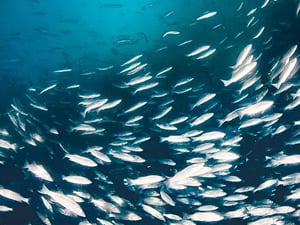Assoc. Prof., Istanbul University, Faculty of Aquatic Sciences, Department of Fisheries and Aquaculture Processing Technology. Dr. Taner Yıldız said that there are many pressure factors, especially overfishing, on the economic fish stocks in the Aegean Sea, and that ecosystem approach fishing should be implemented to prevent this.
Economic species caught in the Aegean include hake, red mullet, bream, sole, angler, anchovy, horse mackerel, butts, bream, mullet, swordfish, bream, kupez, perch, sea bass, blue fish, coral, grouper, bonito, sardine, Sinarit, mullet, shad, mackerel and white tuna species stand out. According to Turkish Statistical Institute (TUIK) data, when the average catch amount from 2013 to 2021 is compared with the catch amount in 2022, it is seen that there is a decrease in most species.
Yıldız explained that there are two types of fishing in the Aegean Sea, small-scale and industrial-scale, as in all coasts of Turkey.
Yıldız pointed out that although the number of small-scale boats is more, their hunting capacity and the number of species they can catch are less, and that a large amount of fishing is done in industrial fishing with trawls and purse seines, since larger boats are used.
Yıldız stated that trawlers hunt more valuable species such as mullet, hake, migratory whiting and deep-water pink shrimp, which live at depth and are called demersal, while purse seines hunt small pelagic species such as sardines and papalina, which live close to the sea surface.
Describing the fish stock in the Aegean Sea as sensitive, Yıldız said, “We have been fishing without control for many years and have worn it out. Currently, climate change and pollution pressure are added to it, but we continue without reducing the fishing pressure. The fishing season and calendar must be rearranged, buyers and sellers must and the biological demands of the fish must be taken into account.” said.
Stating that there is no restriction on the amount of fish in deep water fishing, Yıldız said that although the fishing length is 20 centimeters, he saw hake fish with a length of 5-6 centimeters in the fisheries, and that the pressure of bottom trawling, which is a method used to hunt bottom dwellers, is intense on this fish species. .
Emphasizing that purse seine nets touch the seabed during hunting and damage the habitat there, Yıldız continued as follows:
“In our country, the legal depth limit for purse purse fishing is 24 meters. In the European Union, this figure is 50 meters in depth and you cannot come within 300 meters of the shore. In addition, they cannot enter areas shallower than 70 percent of the length of the purse purse network. Especially in the Mediterranean, the first 50 meters are concentrated in the sea.” “They have meadows. These are aquatic plants that produce oxygen, they absorb carbon, and they provide hiding places for young fish. One of the reasons why we want to introduce the 50-meter rule as soon as possible is that most of the sea meadows are in the Aegean and Mediterranean regions.”
Stating that the first response of economic species to the warming of sea water due to climate change is to change their distribution areas, Yıldız said, “The waters are currently warming towards the north and many fish stay if they can tolerate this temperature, if not, they change their distribution areas towards the north and their numbers decrease.” he said.
Stating that the invasive species and pollution that started to appear in the Aegean Sea along with the sea water temperature are other pressures on fish stocks, Yıldız said that the pollution in the Marmara can be carried in the aquatic environment by flowing to the Aegean Sea via Çanakkale with the upper current. Apart from this, industrial facilities, tourism enterprises and He explained that there are many pollution elements such as ballast water of boats.
Ecosystem approach fishing
Yıldız stated that the protection of species is possible with ecosystem-oriented fishing and made the following recommendations:
“The first 50 meters of the sea are the most productive area and we need to protect the species that are dependent on the habitat here and cannot move. The trawl literally scans the ground it touches. With ecosystem approach fishing, we can take into account the habitat, sensitive species and species that are completely prohibited to catch. If an alien species that competes with our original species comes, we will find our own species.” “We must reduce the fishing pressure on our species so that foreign species do not multiply and replace them. We should encourage hunting of lionfish because it can be consumed, and pufferfish can be made into wallets and shoes because their skin is like the skin of small cattle. We must find areas to use foreign invasive species so that they can be withdrawn from the ecosystem.”
Talking about the importance of introducing a certain fishing quota and a regional fishing mechanism for each boat, Yıldız said, “Our purse purse boats in Samsun and Sinop should not come and fish in Marmara and the Aegean just because there is a lot of fish in them, their region should be clear. Boats bound to Marmara should be in Marmara.” “Boats bound for the Aegean should stay in the Aegean and use the resources there.” made his assessment.
Amounts of fish caught
According to TÜİK data, the 2013-2021 average and 2022 catch amounts of some of the most hunted species in the Aegean Sea across Turkey are as follows:
TYPE 2013-2021 AVERAGE (ton) 2022 (ton)
Berlam 904.5 1083.8
Flounder 2055,4 1066,7
Sea bream 943.5 559.2
Anchovy 176502.1 125980.4
Horse mackerel 13303.7 10981.9
Mullet 892.03 1909.3
Kolyoz 1893.9 2492.9
Sardines 19479.5 16729.1
Tabby 2850.03 1303.8
Issue 2015,1 3146,8
The opinions expressed herein are the author’s and not necessarily those of News2Sea.
#Fish #Aegean #Sea #threat
